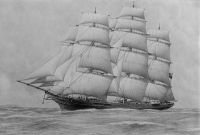
Taeping
In 1866, five clipper ships set out together from Foochow, China bound for England in what would be the last Great Tea Race. On September 6th, one hundred and fifty years ago today, after sailing more than 15,000 nautical miles, the clipper ships Taeping and Ariel arrived in London, literally minutes apart, in what was effectively a tie. The Ariel arrived first, but was delayed in docking due to the tide, which allowed Taeping to get to her dock, beating Ariel by 28 minutes. The third finisher, the clipper ship Serica, docked an hour and 15 minutes after Ariel. The three ships left China on the same tide, raced for 99 days, and arrived on the same tide in London, all less than two hours apart. The clipper Fiery Cross arrived 28 hours behind Serica. followed, the next day, by Taitsing.
Beginning in 1854, the tea merchants of London paid a premium for the first cargo of tea landed each season. The tea clippers of the day raced to see who could claim the premium, which in 1861 was set at 10 shillings per registered ton. Because the race between Taeping and Ariel was so close, the ship owners agreed to split the 10 shilling premium.
Of the five ships racing in 1866, four — Ariel, Taeping, Fiery Cross, and Taitsing — were composite clippers, built with iron or steel frames and keels with wooden planking. Only the Serica was of wholly wooden construction.
The Tea Race became a popular item sporting item in the British newspapers and the basis for many side bets among shipowners. The 1866 race generated a particular flurry of interest in the British press. As exciting and close as the 1866 race was, its closeness was also its undoing. With three ships arriving on the time day and two more over three day period, rather than being able to demand the highest price for the first tea ashore, the tea merchants faced a glut from the five shiploads of tea hitting the markets so closely together.
Also, the tea clippers were not to the first to arrive with a cargo of tea that year. The iron auxiliary team ship SS Erl King left Foochow, China a week after the tea clippers sailed and had arrived in London fifteen days before they arrived in a voyage of only 77 days. In only three more years the Suez Canal would open, giving steamships an advantage over sailing vessels, and ending forever the short-lived primacy of the clipper ships. The age of sail was not over, however. The great windjammers carry lower value bulk cargoes would replace the clippers and hang on for another 50 years before they too were driven from the sea by coal and diesel smoke.

Thank you
One of the few A+ grades I ever earned was a term paper on clipper ships.
Dad and I spent a wonderful afternoon aboard Cutty Sark in Greenwich, London.
Thank you for kindling fond memories.
Interesting story. I am thinking of writing a topic about this too. Was once told that these bets on whether or not these clipper ships would arrive safely inspired what we now know as insurance. There are a few historical books and journals that give a hint to this.
Marine insurance dates back to at least the 14th century.
Thanks Rick. Yes, 14th century or earlier (my guess is earlier) for “insurance”.
Got curious and routed out my notes for “Ships Business” from School of Navigation, Warsash, UK. Marine insurance is the oldest type of insurance and started with the Greek and Roman maritime loans. Things including maritime trade stagnated after the collapse of the Roman Empire for about 500 years. When maritime trading picked up it led to in the 12th. to the Amalfian Laws and in 15th. the Hanseatic League and the Lex mercatoria when a special Court was formed in London, its still there. Later of course there was Lloyds of London.
By the way I passed the “Ships Business” examination with flying colours!
Good Watch.
It is interesting that the principle of general average dates back to around 800 BC. So, the idea of shared risk, which underlies all insurance transactions, is ancient.